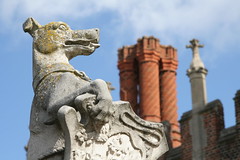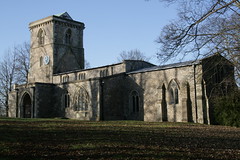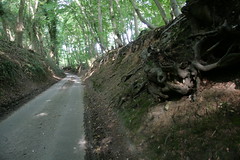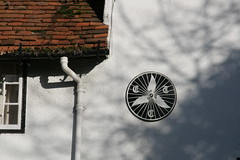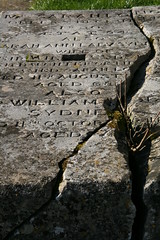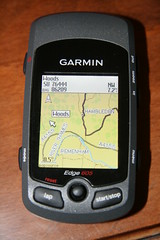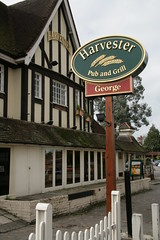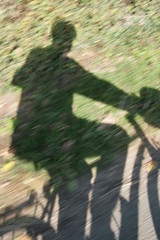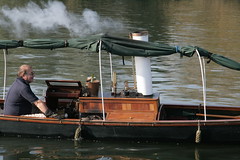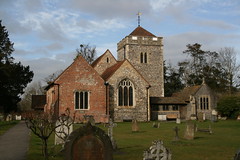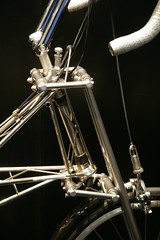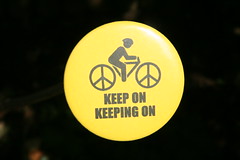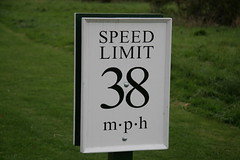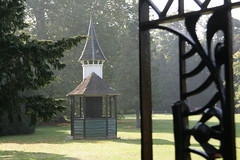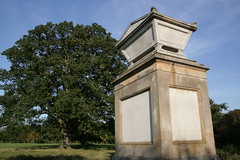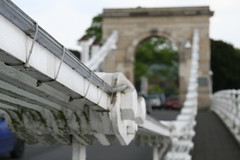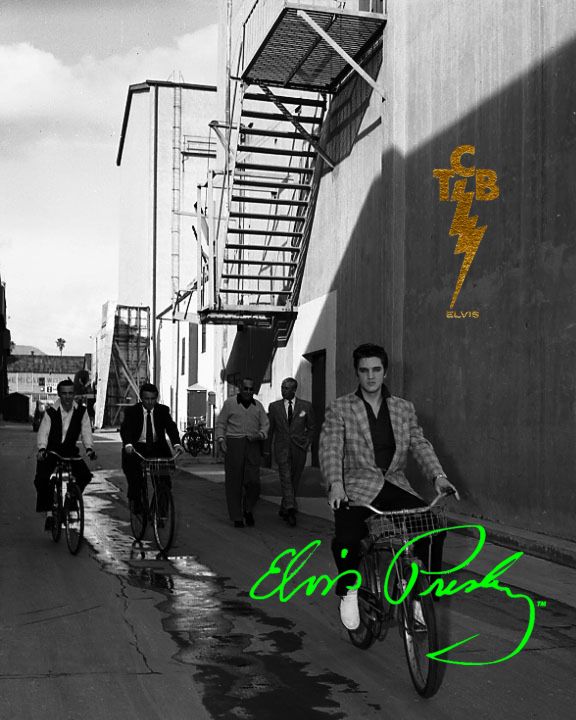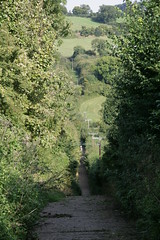Wednesday, 31 December 2008
Statistics for 2008
Eddington number: currently 30, up from 12 at the end of 2007.
Best outing: reaching Ewelme, and the church of St Mary the Virgin- the longest, and final trip in my efforts to reach 12 outstanding English churches, which I completed 7 months early - in May.
Worst outing: returning from Henley, in driving sleet, back in February.
Most memorable cycling event: catapulting myself over the handlebars in Windsor.
Favourite route: the ten mile loop over Winter Hill and Cookham, and back along the Thames to Maidenhead is the route that I have ridden most often, but....
Best route: the circle through Marlow, Frieth, Fingest, and Hambleden.
Activity on this blog: 242 posts (this is number 243), 9,317 hits in 4,314 visits, by 1,620 visitors (including roughly one in a million of European internet users).
And on the way, I'm proud of making a very small contribution to Open Streetmap, including a plot of the Round Berkshire Cycle route
OSM 2008: A Year of Edits from ItoWorld on Vimeo.
Tuesday, 30 December 2008
Advice for 2009
Meanwhile, are there any other suggestions for advice we should be following in 2009?
Sunday, 21 December 2008
Smugfest
I know there are plenty of people covering longer distances, but I've ridden quite bit further than I expected this year: and a lot further than I ever have before.
For ten days, I plan to bask in a self-satisfied glow. Then I'll start a new spreadsheet, with all the dials set back to zero, and start counting a fresh year.
Monday, 15 December 2008
Joke
Two big blue lines walk into a pub, and the barman asks them who they are. "We are a motorway", they reply. "We are the biggest, strongest lines on Open Street Map, and we are afraid of nothing".
Then a red line and an orange line come in, and the barman asks them who they are. "We are a primary road and a secondary road", they say. "We are so tough, we go into places on Open Street Map that even the motorways don't go, because we are afraid of nothing".
Then a couple of thin white lines come in, and introduce themselves. "We are an unclassified road and a residential road. There are more of us than anything else on Open Street Map, so we are afraid of nothing."
Finally a dotted blue line comes in. It weaves about a bit, but the barman notices that everyone else keeps well out of his way. "What's going on?" he asks, "I thought you were afraid of nothing".
"Oh nobody messes with him" they reply. "He's the local cyclepath".
Sunday, 14 December 2008
Pig headed
I started following National Cycle Route 4 from Maidenhead to Hampton Court, with the idea of coming back the same way.
It soon became obvious that there wasn't enough time though. I was too pig-headed to turn back early, and nobody has laid railway tracks from Hampton Court to Maidenhead. So the revised alternative fall-back plan was to reach my original destination, then head north and pick up the Great Western main-line somewhere between Southall and Hayes. Unfortunately, I didn't have the right maps with me, so it was all a bit hit and miss. I got close to Hayes, but then I decided to divert past Heathrow, and I finally caught the train home from Slough.

There were some pleasant stretches - particularly through Windsor Great Park to Egham; and following the Thames path from Walton-on-Thames to Hampton Court, but nobody in their right mind would pick the rest of my route for the scenery. It was all very satisfying though, I expect to sleep well tonight, and after 50 miles, I now only need to cover another 50 to reach my goal of 3,000 by the end of the year.
Friday, 12 December 2008
Cracker jokes
- "What do you call a man with a spade?" Doug.
- "What do you call a man without a spade?" Douglas.
I can only think of one cracker joke related to cycling:
- "Why can't a bicycle stand up on its own?" Because it is two tyred.
There must be more, and probably better: so your suggestions are invited.
Wednesday, 10 December 2008
Missing turkeys

Monday, 8 December 2008
Alex Moulton in 1963

From the British Pathe archive:
Bradford-on-Avon, Wiltshire. Alex Moulton, well-known designer of suspension units for cars, has invented the first bicycle with suspension....
The whole family can ride it, without the slightest embarrassment.
Saturday, 6 December 2008
Holy Trinity, Bledlow
This year I set myself he challenge of cycling to 12 of England's finest churches, using Simon Jenkins book of 1,000 Best English Churches as my guide. It turned out to be less difficult than I expected, and I completed the set in May.
Next year I am planning to reach the next 12.
For the first 12 the distances (as the crow flies) ranged from 3-16 miles, and the actual distance I rode from 16-60 miles. Crows would travel 16-20 miles from here to reach each of the next 12.
But in figuring out which ones to include in the next twelve, it turns out that I had missed one in the first twelve. Holy Trinity at Bledlow is closer than one of the churches I visited this year. So today I thought I would add it to the set.
It was a round trip of 46 miles, over the hills to Marlow then Stokenchurch, down the steep hill to Chinnor, then across to Bledlow. The return jouney started with quite a demanding climb up to Bledlow Ridge, then a long descent into Wycombe, and back home along familiar routes.
The church was locked when I got there, and I wanted to get home before it went dark, so I didn't hang around to look inside. It sounds as though it would be worth it, though. Certainly, if the inside is as pretty as the outside, it will be well worth another visit. And it seems there is a steam railway nearby to add to the visit.
Wednesday, 3 December 2008
Resurfacing
Apparently the amount of damage that a vehicle does to the road is proportional to the fourth power of its weight. If I've got this right, then it means that in nearly 3,000 miles on the bike I have done about as much damage as I do driving the car 60 yards.
I suppose that I contribute my bit towards all the repair work through vehicle duty, council tax, and the rest. I don't drive the distances that I used to, but a decent road surface makes a huge difference on a bike. Particularly in the dark, when it is difficult to spot and avoid a ropey patch. So I can't help feeling that I am benefiting more than most from all this investment.
Tuesday, 2 December 2008
Cycling goals for 2009 (part 1)
Saturday, 29 November 2008
Ascot and beyond
 I'm not doing too badly in my efforts to reach 3,000 miles on the bike before the end of the year. By this morning I had covered almost 2,750 miles, which is a little bit ahead of plan.
I'm not doing too badly in my efforts to reach 3,000 miles on the bike before the end of the year. By this morning I had covered almost 2,750 miles, which is a little bit ahead of plan. Friday, 28 November 2008
Another plug for the legacy media
Thursday, 27 November 2008
Muslim Ladies' Cycling Club
 According to this article in today's Times, increasing numbers of Muslim women in East London are "riding into new cultural territory" with their cycling club. They sound like a great bunch of people, and the article is charming. It also raises all sorts of interesting questions about the way people react to this sort of thing, and about how we react to those reactions.
According to this article in today's Times, increasing numbers of Muslim women in East London are "riding into new cultural territory" with their cycling club. They sound like a great bunch of people, and the article is charming. It also raises all sorts of interesting questions about the way people react to this sort of thing, and about how we react to those reactions.
Monday, 24 November 2008
Welcoming new visitors
Genderanalyzer
 Here's another link from my brother (who clearly has too much time on his hands). Genderanalyser assesses the content of a blog, to decide whether it is written by a man or a woman. Apparently this one is written by a 74% man. Which I suppose is reassuring, sort of.
Here's another link from my brother (who clearly has too much time on his hands). Genderanalyser assesses the content of a blog, to decide whether it is written by a man or a woman. Apparently this one is written by a 74% man. Which I suppose is reassuring, sort of.However, looking at the statistics, Genderanalyser only seems to be marginally more accurate than a random guess would be. Perhaps it will improve over time.
(FWIW, Genderanalyser reckons that it is produced by an 85% man)
Sunday, 23 November 2008
Boundaries

Saturday, 22 November 2008
Winged Wheels
According to the latest figures released by the Department for Transport there are about 4,100 km of road in Berkshire (including Bracknell, Reading, Slough, Windsor, Maidenhead and Wokingham).
I have been playing around with the OSM database, and I reckon that about 4,300 km of Berkshire roads have been mapped on OSM. At first sight, that looks pretty good. However, in areas that have been intensively mapped on OSM (like Edinburgh and Brighton) the length of roads on OSM is more than 50% higher than the figures that the DfT publishes.
All of this is a bit rough and ready, but I'm guessing that the detailed geometry needed for the OSM map includes squiggles that the DfT doesn't count, which results in a higher figure for the length of a road. I can see no reason why the extra squiggles round here should be different from anywhere else, so as a rough guesstimate, perhaps a third of the roads in Berkshire are still waiting to be added to the map.
That's about the same as Bedfordshire, Buckinghamshire, Oxfordshire, and Hampshire. It's slightly better than average for all areas of the UK that I have been able to extract.
If I am going to help improve the coverage of Berkshire, the trick is to find the remaining gaps. And from a selfish point of view, to find holes in the map that I can comfortably reach on the bike, and that promise a reasonably interesting outing.
Today I went hunting round Hurst, near Twyford, which was looking a bit thin, and I found quite a few gaps which I have now traced and added.
There are lots of quiet little lanes round there, and although it is close to the motorway, the area is pleasant enough. The landscape is a bit flat and uninteresting, but at least the lack of hills meant that I could keep up a decent pace. I needed to keep on the move today, because despite the sun, the wind was pretty cold. I hadn't been able to find my gloves when I was collecting all my stuff together, so by mid-afternoon I was getting uncomfortably cold, and I started to head back . About 5 miles from home, I realised that the reason I couldn't find my gloves was that they were in the pannier bag, on the back of the bike. So at least the last five miles was more comfortable.
In the end I had covered 35 miles, filled a bit of a hole in OSM, explored an area that I had never visited before, and discovered this old Cyclist Touring Club plaque on the pub in Hurst.
Wednesday, 19 November 2008
Simple pleasures
Saturday, 15 November 2008
Occupational hazards
 There is a Samsung advertisement in this week's Economist that exposes my flawed perspective on the world.
There is a Samsung advertisement in this week's Economist that exposes my flawed perspective on the world. Scary reaction, but I'm afraid that it's a bit too late for a career change now.
Counting down
Tuesday, 11 November 2008
Cookham
 For one reason and another it has been a few days since I've managed to get out on the bike, but I grabbed an hour this afternoon, in a gap between teleconferences, and I rattled round my favourite route: across Winter Hill, down into Cookham, then back along the river bank and home through the outskirts of Maidenhead.
For one reason and another it has been a few days since I've managed to get out on the bike, but I grabbed an hour this afternoon, in a gap between teleconferences, and I rattled round my favourite route: across Winter Hill, down into Cookham, then back along the river bank and home through the outskirts of Maidenhead.Away from parents collecting their children from school there was very little traffic on the roads, and apart from quite a strong wind, I couldn't have asked for better weather. The view from Winter Hill in the afternoon sun was particularly lovely.
Unfortunately I didn't have a camera with me, so instead, as compensation, here is Stanley Spencer's boisterous painting of Cows on Cookham Moor, which is in the Ashmolean museum in Oxford. Spencer was born and lived in Cookham. The local gallery re-opened recently, and I really ought to try and fit in another visit. But for today an hour in the fresh air, the sight of hawks circling over Winter Hill, and real cows grazing on Widbrook Common will do me very well.
Sunday, 9 November 2008
The most powerful cyclist in the world?
Wednesday, 5 November 2008
2,500 miles
Sunday, 2 November 2008
Warfield
It turned out to be a good plan.
Usually I don't do too badly finding my way around, but for some reason, I seem to have a bit of a mental block about this part of Berkshire. I have got myself lost a few times and followed some unneccessarily convoluted routes. I regularly come to junctions where I expect to turn in one direction, but the road signs point in the other.
Today, a bit of confusion worked to my advantage. I discovered some lovely little lanes, where horses were the only other traffic. With the GPS I managed to trace a few of them (lanes, not horses) and add them to Open Street Map.
What's more, I kept surprising myself by coming across stretches of road that were familiar from previous outings, including the one to the church in Warfield. So now I should be able to piece together the jigsaw in my mind a bit better, and I ought to feel more confident about finding my way around. Time, and future trips will tell whether I am kidding myself.
Saturday, 1 November 2008
De-gapping the map
 I haven't added much to the Open Street Map lately, because I seemed to be running out of local streets that needed adding. That was until yesterday evening, when I went exploring a part of town that is a couple of miles from home.
I haven't added much to the Open Street Map lately, because I seemed to be running out of local streets that needed adding. That was until yesterday evening, when I went exploring a part of town that is a couple of miles from home. Thursday, 30 October 2008
Not a picture of me

This evening I squeezed in a seven mile ride before dinner. It was not the ideal circumstances for riding, with heavy evening traffic, gathering darkness, and a cold wind. I felt a bit daft for venturing out, when I could have stayed warm at home, but at least it cleared my head, and I will have to brave the elements once in a while if I'm going to keep the mileage up over winter.
So it was timely to come across the Icebike site, in a link from Everyday cycling.
Icebike is not a site about "everyday cycling" though. It is the "Home of the Winter Cyclist", and its about cycling in extreme winter conditions. They admit that "it can be really hard to explain this without losing your audience", but they do a pretty good job of conveying the appeal. It is not something that I'll be trying any time soon. But at least I now don't feel quite as daft as I did for venturing out on a cold, windy evening.
Sunday, 26 October 2008
Light relief
But there is one thing that puzzles me.
Each time I push the button on the front light, it changes from a steady light, to a flashing light, then back again. To turn it off I have to hold the button down.
However, holding the button down on the rear light doesn't turn it off. Each time I push the button, the light changes to a different pattern of flashing, then turns off.
What this means in practice is that when I get home, and I want to turn off both lights, I have to hold down the button on the front light, but cycle the back light until it reaches "off" state.
What puzzles me is that these are both lights from the same manufacturer, bought at the same time, that achieve much the same thing, in different ways. Why do they not use the same system? Perhaps there is a logical reason why front and rear lights should work differently, but I can't imagine what it could be.
Can anyone tell me whether this is a design flaw, or a feature?
Saturday, 25 October 2008
Devil's Highway
On the way out I followed National Cycle Route 23 from Reading to Silchester, parts of which touch on the old Roman road.
On the return journey I followed the Round Berkshire Cycle Route from Beech Hill to Arborfield. There wasn't enough time for my original plan, which was to stay as close as possible to the Devil's Highway. That would have brought me back through Finchamstead, Crowthorne, and Sunninghill to Windsor.
Instead I took a more direct route home, through increasing darkness, via Wokingham and Twyford.
XLVII miles in total.
Wednesday, 22 October 2008
Hi ho silver
I work from home, and at the moment, if the weather is decent, I am trying to finish work by 5:30, then get out for an hour on the bike before dinner. By the time I get back, the meal is almost ready, and there is just time to put the bike away and scrub up before we eat.
Monday, 20 October 2008
OSM cycle map on Garmin Edge
A couple of months ago I was regularly picking out a local village or estate that hadn't been mapped, and using that as an excuse for an evening ride. But as the amount of detail on the map builds up, there are fewer blank areas within easy reach of home, and even on longer trips I keep discovering that somebody else has already plotted the main roads.
I haven't completely stopped adding details. Sometimes I come across a road that hasn't been plotted before, or that has only been plotted roughly, but I need to get myself better organised if I'm going to be more useful.
Various good people have put together the tools to build and transfer OSM cycle maps to a Garmin GPS system. The maps themselves can be downloaded here. But it has been about three months since the downloadable UK maps have been updated.
So it seemed like a good idea to use the tools and produce my own version of the map.
I'm reasonably proficient with software, but it took a bit of trial and error to make it all work. To be honest, that is not so much a problem with the tools. It's really because I tend to rush into trying things out without reading the instructions properly. In any case, as the picture shows, I got it all working before too long, and now my GPS contains what seems to be a complete OSM cycle map of the UK.
So far I have used the default settings, but if I understand it right, there are lots of options that I can play with to change the format.
The met office are promising better weather tomorrow. If they are right I will go for a ride. But if they are mistaken, and we have another stormy evening, then I can always sit at home in the dry and twiddle.
Saturday, 18 October 2008
Retro ride
 Most of the time I ride by myself, but today I rode with the ghost of Charles G. Harper.
Most of the time I ride by myself, but today I rode with the ghost of Charles G. Harper. After Ruislip, the road climbs up Duck's Hill, of which Charles says the "gradient and the quality of the road-surface render this bit particularly dangerous". He is also exercised about the steep descent into Rickmansworth, which apparently, the CTC had marked with a "danger-board" in 1902. Today there is a standard steep hill sign at the top. I ignored Charles' advice to walk down this hill, on the basis that brakes are more effective these days, but I did note that the descent ends with a brick wall, some cottages, and a canal; and remembered his suggstion that if all else fails, on a runaway bike, it is best to aim for the canal.
Friday, 17 October 2008
Vélocipèdes, Luchon
Wednesday, 15 October 2008
lliH retniW
Each of the loops has a different character: so I can chose between something quiet, better views, or a flatter and faster ride depending on my mood. I am also learning that each loop works best at a different time of day. I avoid some at rush hour, because of heavy traffic; and some work better after dark than others.
That choice makes for some variety, but the route over Winter Hill, with the most quiet roads, and the best views, is the one I choose more often than any of the others. I must have ridden it, clockwise, a couple of dozen times - but until tonight I have never ridden it anti-clockwise.
In theory, anti-clockwise is best in the UK, because it normally means turning left at a junction, but in this case a clockwise route involves easier climbs, and sharper descents. The road down from Winter Hill into Cookham is exhilarating, but the climb from Cookham up to Winter Hill has always looked a bit daunting.
In practice it didn't really turn out that way. There are a couple of sharp ascents, but they don't last very long, and there is a level piece of road as a break between. I wouldn't say that I managed the climb without effort, but it wasn't nearly as tough as I expected.
The road was familiar, of course, but seeing everything from a different direction made for a bit of a change. More importantly, I've discovered that some hills might not be as challenging as they look.
Tuesday, 14 October 2008
"On track to get all his colleagues cycling"
From today's Guardian...
"The idea for a college bicycle library was to collect bikes in any condition, do them up and lend them to students and staff who needed a bike to get around"
"Once I got the go-ahead from the college, I set about acquiring some bikes. We got our first from a guy at Street Scene, where the city's street cleaning machines are stored. We asked him to look out for bikes for us. Our next lot were donated by the Campaign Against Climate Change and the Bicycle Recycling Initiative Manchester. We've been offered some from the local police station and more are coming in from staff all the time. We've now got 23."
Sunday, 12 October 2008
Steam canoe
In the end, the short bike ride turned into 36 leisurely miles. With a late start, and a couple of extended breaks, it took up most of the day.
It was a cold morning, and there was quite a lot of fog, which the sun didn't break through until noon. By then, I had worked my way up to Stokenchurch, via Marlow and Lane End. Things soon warmed up after that, with lovely, hazy views along the valley as I cycled down through Ibstone, past the "Chitty Chitty Bang Bang" windmill at Turville, and through Skirmett to Hambleden.
After a break for a late lunch, I had planned to head home through Marlow, as usual, but it was such a lovely day I headed in the other direction instead, along the bank of the Thames to Henley. Lots of people were out enjoying the day, including canoeists riding the sluice at Hambleden weir, this steam canoe, and various other boats, walkers, and a golden retriever with a gale in its tail.
From Henley I headed back home through Warren Row.
I'll need to do some catching up on work tomorrow, but that's a small price to pay for a glorious ride. It would have been a terrible waste to use the day more responsibly.
Saturday, 11 October 2008
The knell of parting day
Depending on the weather and other commitments, I normally manage to fit in one long ride at some point over the weekend, but my riding varies more during the week.
During the longer days of summer, I often managed to fit in at least a couple of hours on the bike after dinner. The day had cooled down by then, and I had time to cover twenty miles, or thereabouts. Now it has got too dark to ride after dinner, so I am trying to squeeze in an hour before dinner. In an hour, by the time I get my stuff together, I only manage to cover about ten miles.
Ten mile circuits have to be fitted into quite a small local area. I've developed a few standard routes, so I can ring the changes, without too much planning. Still, it means that I am going back over familiar ground quite a bit. So it was a treat on friday when I startled a fox on one of the lanes leading back into Maidenhead. For a short while the fox ran ahead of me down the lane, then it disappeared into the hedge. I know that a fox is not exactly the kind of thing that would stir Simon King on Big Cat Live, or Spring Watch, but for me there is something exciting about seeing one at close quarters. It was certainly unusual enough to turn a perfectly nice, but rather mundane ride, into a bit of an event.
Friday, 10 October 2008
Here's a treat
THE ROADS OF ENGLAND AND WALES;
AN ITINERARY FOR CYCLISTS, TOURISTS, & TRAVELLERS
Containing descriptions of the contour and surface with mileage of the main direct and principal cross roads in England and Wales and part of Scotland;
particularly adapted to the use of BICYCLISTS and TRICYCLISTS
(Charles Howard, 1889)
As it says in the preface:
"It cannot be denied that Cycling, ever since its introduction into this country as a means of locomotion, has been in want of a reliable Road Book specially adapted for its requirements—in short, one that will afford full information as to mileage, hills, and surface of, at least, the great trunk roads.
A strong proof of this, if any be needed, can be readily found by reference to the columns of the papers devoted to the pastime, where enquiries about roads, &c., may be seen almost every week."
The book mainly covers the main roads, and it is interesting to compare the situation 120 years ago with what we find today. Here, for example is a description of one road that I am very familiar with, from Slough to Reading, which is still recognisable as the A4:
Slough to Maidenhead is a gently undulating road, chiefly downhill, through Salt Hill; good smooth surface, but inclined to be loose and sandy occasionally, with a bad and heavy bit just before Maidenhead Bridge, where cross Thames; macadam through the town. (Maidenhead: Bear; Bell; Cleare's; Cliveden, Queen St., Hqrs.; Lewis's; Queen's Arms; Ragmead; Railway; Saracen's Head ; Thames; White Hart.) 2 or 3m. on r., Burnham Beeches, lately purchased for public recreation by the Corporation of London.
At Maidenhead Bridge, on r., Taplow Ho., and 3m. Cliefden and Dropmore Lodge. 1m. S. of Maidenhead, the village of Bray, of " The Vicar of Bray" fame.
Maidenhead to Twyford; hill to mount out of the town, then first rate level road to Stubbings Heath or Maidenhead Thicket, (where keep to L.), and the rest is rather hilly by Littlewick Green, Knowl Hil, Kiln Green, and Hare Hatch; capital smooth and hard road. Pretty scenery.
Twyford to Reading is undulating, chiefly on the rise for two-thirds of the distance, ending with a long gradual fall just before Reading ; capital smooth road, but not quite so firm a surface as the preceding stage ; macadam through the town, in which turn to L. into Minster street for the Bath road. (Reading: Black Horse; George, B.T.C.; Great Western; New Albion; Queen's; Upper Ship; Wheatsheaf.)
2m. past Twyford, on r., Holme Park.
At Reading are remains of a Benedictine Abbey, built 1121. St. Mary's, St. Lawrence, and the old Greyfriars are the most interesting churches. Here is the large biscuit manufactory of Huntley and Palmer. On r., across R. Thames, Caversham Park.
The whole book can be downloaded here
Cycle show
Apparently the way to think of it is this....
Every few years we spend several thousand pounds replacing the car. If we miss out just one of those purchases, then I can afford one of these. And it will last a lot longer than a car.
It all made perfect sense at the time, but thankfully I didn't sign anything.
Thursday, 9 October 2008
I never realised that I needed...
 ...a tyre cleaning brush.
...a tyre cleaning brush.It is full of wonderful stuff, including wooden rims and acetylene lamps, with some fishing rods, rifles, dog collars and hammocks for good measure. Just 108 years too early for Christmas.
Wednesday, 8 October 2008
Slogan for the times
Tuesday, 7 October 2008
Working the numbers

The rows at the top record daily rides and calculate weekly statistics, while the boxes at the bottom show progress against various goals. It also generates various charts, such as this one showing week totals, and various averages:

The idea is that by setting myself goals, and tracking progress, I am more likely to overcome inertia, and hence get out and ride more often, further, and more energetically.
I know this won't work for everyone, but on the whole it seems to be working for me.
At present I am on track to cover more than the 2,500 miles that I am aiming to cover over the year. I am trying to ride 56 miles each week, and though I only achieve this 60% of the time, I average more - at nearly 58 miles a week. In any week I try to get out on the bike more days than not, and I do average four trips a week - though half of the time I am doing fewer rides in a week.
The spreadsheet also tell me that my Eddington number is 27, I have ridden nearly four times as far on my current bike (in 9 months) as I did on the previous one(in 18 months); I have ridden my metric age 17 times, and my imperial age four times; I am approaching Berlin on my virtual European tour, and I would be a third of the way round the moon, if I had been riding up there this year.
Depending on weather and other commitments, my distances fluctuate quite a lot from week to week. I can see that my longest trips were in May and June, and I haven't had a stretch of more than 45 miles since. Similarly, my total weekly mileage grew to begin with, but is settling down at a fairly consistent 58 miles a week.
All this has been a bit of an experiment to see what works, and what doesn't. So the whole spreadsheet has got a bit messy and over-complicated. It needs tidying up for next year, and some of the goals will need to be reset.
Meanwhile the ground-rules seem to be:
- It's best to set goals that are challenging but not too difficult. 56 miles a week was a lot more than I was doing previously, and setting it fairly high forced me to change my approach. But if it had been much higher, failure would have been inevitable, which would act as a discouragement, rather than an encouragement.
- Without some prior knowledge of how difficult things are going to be, it is OK to set an initial goal, as an experiment, then change it in light of experience. It is far more encouraging to aim low initially, then raise the goal, rather than the other way round.
- It is better to set objectives where it is possible to recover from a glitch, rather than ones where success and failure are absolute. Originally I was aiming to do at least four rides every week. Inevitably, a week came when it was impossible to do four rides. So I changed the goal to an average of four rides every week. That way, after missing too many days, a bit more effort in the subsequent weeks will get me back on track.
- It helps to set a mix of objectives, so that on different days, in different moods, there is always something to work on. For example, when a long ride is impossible, it is best if there is still an incentive to go for a short ride
- It is important to set some long-term and some short-term goals. Seeing real progress towards a big long-term goal is more encouraging than repeatedly achieving small short-term goals. It is also far too easy to postpone work on a big, long-term goal, thinking that there will be plenty of time later
- I like to express long-term goals in silly ways. I find it quite encouraging to pass the big round numbers (1,000 miles; 2,000 miles, etc.) but sometimes there is a long gap between them, and despite my age (or perhaps because of my age), I get childish pleasure from imagining that I have reached Paris, Rome, or Venice on the bike.
Saturday, 4 October 2008
The Boring Version
I looped around Windsor Great Park a bit, and stopped for a coffee at the Riverside Station in Windsor, covering 30 miles in total. Not quite as far as the original plan, but about enough, since the aches and pains from last week's tumble haven't entirely gone away, and the weather was less than perfect.
Despite a rather grey day, it was a very pleasant and relaxing ride - with nothing too strenuous. Spotting this peculiar speed limit in Windsor Great Park was pretty much as exciting as things got. Goodness knows why they picked that particular number. But then, where's the fun in being a monarch if you can't set wacky speed limits in your own grounds?
Friday, 3 October 2008
Sheringham

The only reason for posting this is that I like the picture. It is from the National Monuments Record, the archive of English Heritage. It was taken by John Gay, and shows Sheringham Station in Norfolk, in 1959.
Thursday, 2 October 2008
Per ardua ad astra

"The objective of the Interplanetary Internet project is to define the architecture and protocols necessary to permit interoperation of the Internet resident on Earth with other remotely located internets resident on other planets or spacecraft in transit".
As a concept, I find that a bit hard to get my head around, so it's a relief to know that somebody else is working on it. However, it can only be a matter of time before an inter-planetary internet is going to lead to inter-planetary cycling blogs, and slippy inter-planetary streetmaps, and the like. And obviously I am keen to be up there with the pioneers.
By my reckoning, my mileage on the bike this year would get me less than 1% of the way to the moon, and even those who have cycled around the world would only have covered 1/6 of the distance to the moon. So I doubt whether a bicycle is ever going to be a practical proposition for inter-planetary travel.
However, cycling around other planets and moons looks a more sensible idea. My annual mileage would get me a third of the way round the the moon, a quarter of the way round Mercury, or a sixth of the way round Mars.
Presumably my GPS system wouldn't work up there, so I would need to find another way of mapping the Martian street network. But there is plenty time to work out minor details like that, and with work on an inter-planetary internet already under way, that's one less thing I have to worry about.
Sunday, 28 September 2008
A minor accident statistic
So I set off in high spirits for a good long stretch.
However, as I came into Windsor, the front wheel hit a rut at an awkward angle, which caused me to swerve. I braked hard to avoid going into the traffic, and flew straight over the handlebars. Not exactly good braking technique; and certainly not the most dignified way to come to a rapid halt.
I'm proud to say that I then managed to execute quite an elegant three-point landing, on my forehead and knuckles. Thanks to the helmet, there was no serious damage done. I am a bit grazed and bruised, and I broke the face of my watch, but the bike landed on top of me, so it is fine.
At first I felt a bit shaken though, so I took my time getting started again, with every intention of continuing the ride. However, after the third person had stopped to check that I was OK, and offer me help, I was holding more baby-wipes than I knew what to do with, and I had come to the conclusion that things must look a lot worse than they really were. So I decided it was better to go home and get myself cleaned up.
I ended up covering just 17 miles, on a day when I intended to do about twice that. I am disappointed that I didn't get to take more advantage of such lovely weather. I clearly need to improve my braking technique, but the more important lesson from the whole experience is that three complete strangers went out of their way to show concern and offer support. Their help wasn't neccesary, but that isn't the point: by taking the trouble, they turned what could have been a bad experience into a very positive one.
Saturday, 27 September 2008
Memorial to Thomas Gray
The parts of the circuit nearest home are very familiar, while the rest covered ground that I have cycled before, but not for a while.
I seem to have picked quite a popular route, and saw a lot of other cyclists out for ride on a lovely autumn evening. In retrospect perhaps I could have avoided quite so many busy roads, and uninteresting suburbs. On the other hand, Burnham Beeches was looking very fine, with low sun filtering through the trees; and by the time I crossed back over the Thames at Cookham, the rich, low sunlight made the river look like molten metal.
On balance it wasn't such a bad mix.
How to....

The Guardian has been publishing a series of "how to" booklets this week on different kinds of writing (Journalism, Children's books, Poetry, Biography, etc.), but, curiously, nothing on how to write a cycling blog. however, there is quite a lot of advice out there on the internet about blogging in general. You can google it as well as I can, so I'm not going to suggest anything specific, except for this, which seems pretty sound.
Friday, 26 September 2008
Accident statistics
The Department for Transport has just published the accident statistics for 2007.
The number of pedal cyclists killed or seriously injured works out as one every 500,000 journeys, or one every 1.9million kilometres (one every 1.2million miles).
The risk of death is similar for a pedestrian and a cyclist, over the same distance, but a pedal cyclist is around three times more likely to be killed on an average journey than a pedestrian because the average bicycle journey is longer than the average walk.
Pedal cycle casualties have decreased by 34% compared to ten years ago, but remain at a similar level to 2006, despite an 8% decrease in cycle traffic - in other words, the rate has increased by 9%.
The number of pedal cycle fatalities has fallen by 7% from 146 in 2006 to 136 in 2007, and shows a 27% decrease from the number 10 years ago (the actual baseline they use is in an average of the figures from 1994–98).
The full report is here
Thursday, 25 September 2008
Back on the bike
The bike shop have done a good job, and the bike seemed to be running very sweetly. I don't suppose that's because there is anything magic about the new part: more likely because it has now all been set up properly.
I wish I could say the same for myself. It's only been a week away from the bike, but I definitely felt off my best form, and I couldn't possibly describe my legs as running sweetly.
The ride out involved quite a steep climb, but the lanes back from Handy Cross to Little Marlow, were a real treat. It's a stretch of a couple of miles, downhill all the way, through lovely woodland, and I went past a surprisingly large number of pheasants.
Monday, 22 September 2008
Solutions to a "Helmet Hair" problem
According to a survey commissioned by Cycling England, and reported in the Independent, 27% of women are put off cycling to work by fear of "helmet hair". It doesn't say whether many men share this concern, which until ten minutes ago, had never even occured to me. But perhaps we should be worried too.
Thankfully, as ever, Bike Forums has been ready with answers for the last three years. If I want to be sure that people don't point at me and laugh at my helmet hair, all I have to do is pick one of their many solutions:
- Shave my head
- Grow a ponytail
- Wear a bandana
So, why are all those people still pointing and laughing?
Sunday, 21 September 2008
City cycling and advocacy
It is an easy read, and informative, but very much a book of its time, and entertaining partly for a slighlty old-fashioned style.
Today I found myself in a bookshop, and out of curiosity I bought a copy of Richard Ballantine's latest book, City Cycling.
I've only skimmed the book so far, but Mr Ballantine has clearly lost none of his enthusiasm over the last 35 years, while book production has advanced. It seems to me that he puts over some important principles in an entertaining way. However, I think he see his main audience as people who have not yet tried cycling, or at least not in the recent past. As a result he puts a lot of effort into advocating that readers take it up. The spirit is captured by the strapline: "Get fit / save time / save money / save the planet".
For this target audience he seems to cover most of the bases: how to buy a bike, security, handling skills, maintenance and repairs.
But personally I find it hard to engage with the advocacy running through City Cycling. The problem, I suspect, is that I no longer feel that I am part of the audience that he is mainly concerned with - simply because I have already taken up cycling. My priority is now to make sure that I stick at it, and keep putting in the effort.
I'm too old and decrepit to be pursuing a goal of outstanding athletic achievement, and unfortunately, faced with the choice of going for a ride, or not going, then none of these arguments that it will save time, save money and save the planet really cuts it as a good enough reason to get out of the armchair.
As my family knows well, the best way of persuading me to get the bike out of the shed and go for a ride is "you'll enjoy it"; or "it will make you feel better". When I really don't feel like going for a ride, I can still talk myself out of the chair to go in search of a bit of an adventure, to work off a bit of stress, to see if I can beat a previous performance, or just to keep my various graphs moving in the right direction.
It is for these reasons that cycling is gradually becoming part of my routine. At times like today, when I can't get out on the bike because of mechanical problems, I am finding that I miss it.
So if you are considering taking up cycling, particularly cycling in an urban context, then I suggest you take a look at Richard Ballantine's book. I hope you find that he provides useful advice, in an entertaining way. If, like me, you feel that you have progressed to the next stage, then tell me whether I am being unfair to wonder why so many advocate that we take up cycling in the first place; while fewer seem to realise that subsequently we still need to be encouraged to go for a ride?
Wednesday, 17 September 2008
Question on insurance
Bikes have feelings too
 I'm not going to be doing any riding over the next few days, because I've broken the rear derailleur, and for one reason and another I cannot get it fixed until next week. I took off the rear wheel a couple of evenings ago, to check that the puncture repairs that I had done on the side of the road were looking OK. I think I must have put the wheel back on crookedly, because as soon as I pressed on the peddle there was a crack, and the rear derailleur fell off. It's all looking very sad and I feel sorry for the poor bike. I suspect I could fit a new derailleur but I'm not sure that my skills are sufficient to get all the adjustments right. So I've booked the bike into the local bike shop so she can have some professional surgery.
I'm not going to be doing any riding over the next few days, because I've broken the rear derailleur, and for one reason and another I cannot get it fixed until next week. I took off the rear wheel a couple of evenings ago, to check that the puncture repairs that I had done on the side of the road were looking OK. I think I must have put the wheel back on crookedly, because as soon as I pressed on the peddle there was a crack, and the rear derailleur fell off. It's all looking very sad and I feel sorry for the poor bike. I suspect I could fit a new derailleur but I'm not sure that my skills are sufficient to get all the adjustments right. So I've booked the bike into the local bike shop so she can have some professional surgery.Sunday, 14 September 2008
A fine ride with cake
The route is well signed on the ground, but it took some finding on a map. As far as I can tell, the only place it has been published on the interweb is in a fairly obscure Buckinghamshire transport strategy document. Which is odd, because it is a fine route through lovely countryside, with a choice of good places to stop off on the way. Whoever first laid it out had a good eye for landscape, but unfortunately either they had a bit of a blind spot for hills, or a wicked sense of humour, because there are some pretty challenging climbs, including this steep farm track linking a couple of roads north of Marlow.
I traced the route on the GPS, and I've tagged it on Open Streetmap, so it will appear towards then end of this week when the cycle map is re-generated. But regular visitors to Tlatet, will, I am sure, have an urgent need for more detail.
So here we go. In outline the route climbs to the north of Marlow, as far as Frieth, then turns west, through Fingest, and south through Hambleden. In the past I've taken the road through Bovingdon Green out of Marlow, and the A4155 from Hambleden back, but this route starts out along the B482 on the way out, and on the return uses narrow lanes to climb through Rotten Row to Marlow Common, before dropping back into Marlow. It also takes a slightly different back route through Hambleden.
As far as the fauna goes, the highlights today were a small deer that crossed the road about 100 yards in front of me; and a number of large birds of prey, flying low across the road - presumably searching for small rodents in the fields.
When I reached Hambleden, at about 4pm there was a choral concert in the church, and they were serving tea and cakes in the churchyard. I joined a small group sitting outside in the sun, listening to the music through the windows. I'm not a great tea drinker, and the best I can say about the coffee was that it was warm, brown, and wet; but the selection of cakes was awesome. I finally settled for some cinammon flapjack - which was delicious - but it was a tough choice.
By the time I had made my way to Marlow and home, the whole ride turned out to be just over 30 miles (the loop itself is about 15 miles from Marlow and back).
Next time I can't rely on such a lovely afternoon, and cakes in Hambleden churchyard, but I'll be back, because this is one of the best routes that I've found at around that length. Next time I might even manage to do a bit better on the steep hills. There are plenty of good places to stop for a break; and it looks to be popular with cyclists (several passed me on the hills). So it seems odd that the route isn't named and publicised more widely.
Or perhaps I've missed something. If so, please let me know.


